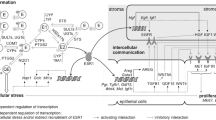Summary
The influence of ethinylostradiol on hepatocarcinogenesis was investigated in the female Dawley-rat. After 14 weekly gastric instillations of 50 mg diethylnitrosamine/kg and simultaneous administration of diet supplemented with ethinylostradiol 10 mg/l kg diet, 77.8% of the rats developed a hepatocellular carcinom. In contrast, only 31.8% had carcinoma of the liver under similar experimental conditions. The relation of preneoplastic lesions correlated with that of carcinoma induction in both groups. If the results were to be valued on clinical relevance without difficulties a new orientation on surgical indication and transformation of the dignity of benign focal nodular hyperplasia would have to be considered.
Zusammenfassung
Der Einfluß von Äthinyloestradiol in der Hepatocarcinogenese wurde an Dawley-Ratten untersucht. Nach 14wöchentlicher intragastraler Applikation von 50 mg Diäthylnitrosamin/kg entwickelten bei simultaner Verabreichung von Äthinyloestradiol im Futter 77,7% der Tiere ein hepatocelluläres Carcinom. Dagegen wurde nach Behandlung mit Diäthylnitrosamin allein unter ähnlichen experimentellen Bedingungen Leberkrebsinduktionen nur bei 31,8% beobachtet. Präneoplastische Veränderungen korrelierten mit der Relation der Krebsinduktion in beiden Gruppen. Könnte man von den Ergebnissen eine klinische Bedeutung ableiten, müßte eine neue Standortorientierung über chirurgische Indikation und spätere Dignitätsänderung der benignen focalen nodulären Hyperplasien stattfinden.
Similar content being viewed by others
Literatur
Bannasch P (1967) Nitrosamin-induzierte Glykogenese und Geschwulstbildung in der Rattenleber. Verb Dtsch Ges Pathol 51:343–350
Baum JK, Holtz F, Bookstein JJ, Klein EW (1973) Possible association between benign hepatomas and oral contraceptives. Lancet 11:926
Blumberg BS (1977) Australia antigen and the biology of hepatitis B. Science 197:17–25
Dammermann R, Gurtler KF, Kläppel G, De Heer K (1979) Benigne Lebertumoren nach Einnahme oraler Kontrazeptiva. Inn Med 6:115–122
Druckrey H (1951) Experimentelle Beiträge zum Mechanismus der cancerogenen Wirkung. Arzneimittelforschung 1:383–394
Druckrey H, Preissmann R, Invankovic S, Schmähl D (1967) Organotrophie carcinogene Wirkung bei verschiedenen N-Nitroso-Verbindungen an BD-Ratten. Z Krebsforsch 69:103–201
Edmonston HA, Henderson B, Benton B (1976) Liver cell adenomas associated with use of oral contraceptives. N Engl J Med 294:470
Forman D, Doll R, Peto R (1983) Trends in mortality from carcinoma of the liver and the use of oral contraceptives. Br J Cancer 48:349–354
Francavilla A, DiLeo A, Eagon PK, Ove Wu S, Van Thiel DH, Starzel TE (1984) Regenerating rat liver: Correlations between estrogen receptor localization and deoxyribonucleic acid synthesis. Gastroenterology 86:552–557
Goodman ZD, Ishak KG (1982) Hepatocellular carcinoma in women: Probable lack of etiology association with oral contraceptive steroids. Hepatology 2:440–444
Gräfl KJ, Meyer zum Büschenfelde KH (1980) Leberzelltumorinduktion durch orale Kontrazeptiva. DMW 103:61–65
De Heer K, Sauer HD, Klöppel G (1981) Die tumorhemmende Wirkung von Cholestyramin in der Hepatocarcionogenese. Langenbecks Arch Chir 354:19–29
Kern F (1978) Effects of estrogens on the liver. Gastroenterology 75:512–522
Mackinson AM, Simon FR (1975) The pharmacological reversal of cholestasis induced reduction in hepatic P-450. Biochem Pharmacol 24:748–749
Magee PN, Farber E (1962) Toxic liver injury and carcinogenesis, methylation of rat liver nucleic acids by dimethylnitrosamine in vitro. Biochem J 83:114–124
Magee PN (1962) Biochemical and pathological mechanism in experimental liver cancer. Sci Basis of Medicine. Annual Review 172–202
Popper H (1977) Durch Umweltfaktoren verursachte Lebertumoren. Internist 18:182–187
Scherer E, Emmelot P (1975) Kinetics of induction and growth of precancerous liver cell foci and tumor formation by diethylnitrosamine in the rat. Eur J Cancer II:689–696
Schuppler J, Grunzel P (1979) Liver tumors and steroid hormones in rats and mice. Mechanism of toxic action on some target organs. Arch Toxicol [Suppl] 2:181–195
Wanless IR, Medline A (1982) Role of estrogens as promotors of hepatic neoplasia. Lab Invest 46:313–332
Author information
Authors and Affiliations
Rights and permissions
About this article
Cite this article
de Heer, K., Klöppel, G. & Schreiber, H.W. Äthinyloestradiol und Hepatocarcinogenese. Eine experimentelle Beobachtung. Langenbecks Arch Chiv 370, 163–171 (1987). https://doi.org/10.1007/BF01259536
Received:
Issue Date:
DOI: https://doi.org/10.1007/BF01259536




